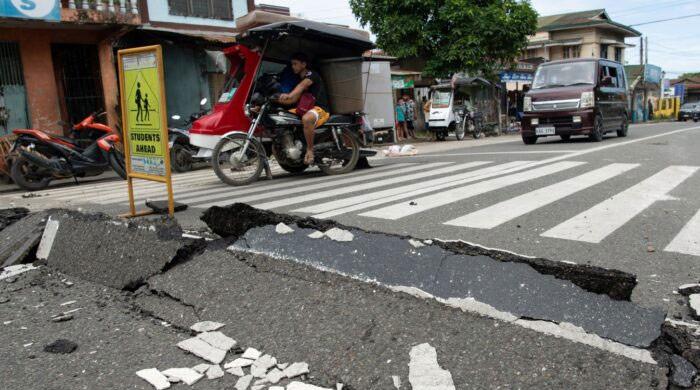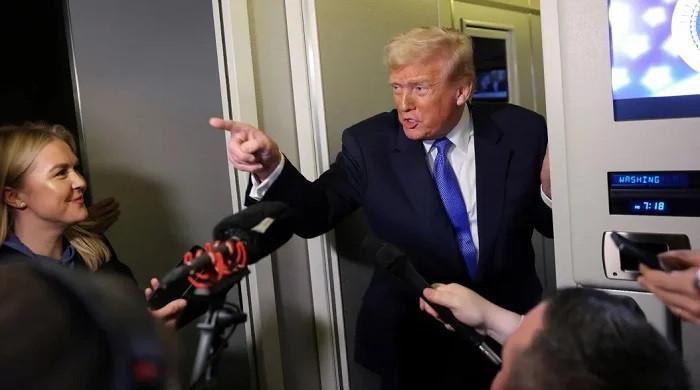Politics
Philippines quake death toll climbs over 60; injured overwhelm hospitals


- More than 150 injured in quake, say officials.
- No tsunami threat, multiple aftershocks recorded.
- President Marcos Jr expresses condolences.
The death toll from a powerful earthquake in the central Philippines has climbed to over 60 on Wednesday, with injured patients overwhelming hospitals on the island of Cebu as workers carried dozens of body bags away in the chaotic aftermath.
The shallow magnitude 6.9 quake struck at 9:59pm (1359 GMT) Tuesday off the island’s northern end near Bogo, a city of 90,000 people, according to the US Geological Survey (USGS).
Injured children cried and adults screamed while receiving treatment on beds laid out beneath blue tents on the driveway of the Cebu Provincial Hospital in Bogo.
They had been wheeled out of the building amid fears of further harm as hundreds of aftershocks rocked the region overnight.
Nearby, hospital workers carried black body bags on stretchers into vans that will take them to local mortuaries, AFP journalists saw.
Up to 60 people are reported killed so far, Office of Civil Defence deputy administrator Rafaelito Alejandro said.
“We are receiving additional numbers of reported casualties so this thing is very fluid,” he told reporters in Manila.
The National Disaster Risk Reduction and Management Council earlier listed 147 injured across the central islands, where 22 buildings were damaged.
Rescuer Teddy Fontillas, 56, told AFP he had not slept a wink, adding some patients had to be moved to other hospitals because the one in Bogo was already overflowing.
“We are already overwhelmed, so we have to bring them to the city,” he said, referring to the provincial capital Cebu, some 100 kilometres (60 miles) to the south.
“I’m already struggling, but what we are doing is necessary to help our patients,” he added.
“Because of the high volume of patients with serious injuries, the medical staff tended to some of them outside the hospital,” Cebu provincial governor Pamela Baricuatro posted on her official Facebook page.
Dramatic footage filmed by residents and widely shared on social media showed an old Catholic church on Bantayan island near Cebu adorned with a string of light bulbs swaying wildly shortly before its belfry tumbled into the courtyard.
“I heard a loud booming noise from the direction of the church then I saw rocks falling from the structure. Luckily, no one got hurt,” Martham Pacilan, 25, who was nearby when the belfry collapsed, told AFP.
Local television showed riders being forced to dismount from their motorcycles and hold onto the railings for dear life as a Cebu bridge violently rocked.
‘The mall started shaking’
Buildings were damaged as far as Cebu city, where online shoe merchant Jayford Maranga, 21, hid under a restaurant table to avoid being struck by the collapsing metal ceiling of a shopping mall.
“My friend and I ate at the food court near closing time, and then, bang! It was as if the Earth stopped spinning. And then the mall started shaking,” Maranga told AFP, adding his friend was slightly injured.
The Cebu provincial government has put out a call on its official Facebook page for medical volunteers to assist in the aftermath of the quake.
“There could be people trapped beneath collapsed buildings,” provincial rescue official Wilson Ramos told AFP.
Overnight recovery efforts were hampered by the dark as well as aftershocks, he added.
The rescue effort proceeded all night, even as the Philippine Institute of Volcanology and Seismology said the region was being rocked by 379 aftershocks.
The quake caused power lines to trip, leading to outages across Cebu and nearby central islands, though power was restored shortly after midnight in Cebu and four other major central islands, the National Grid Corp. of the Philippines said in an updated advisory.
The Cebu provincial government reported a commercial building and a school in Bantayan had collapsed, while a fast food restaurant in Bogo was heavily damaged.
Agnes Merza, 65, a carer based in Bantayan, said her kitchen tiles had cracked.
“It felt as though we would all fall down. It’s the first time I have experienced it. The neighbours all ran out of their homes. My two teenage assistants hid under a table because that´s what they were taught in the Boy Scouts,” she told AFP.
A number of village roads also sustained damage. In Tabogon town, the road was riddled with five-centimetre (two-inch) cracks, AFP journalists saw.
The USGS had reported a magnitude reading of 7.0 before revising it down, while the Pacific Tsunami Warning Centre said there was no tsunami threat from the earthquake.
Quakes are a near-daily occurrence in the Philippines, which is situated on the Pacific “Ring of Fire”, an arc of intense seismic activity stretching from Japan through Southeast Asia and across the Pacific basin.
Most are too weak to be felt by humans, but strong and destructive ones come at random, with no technology available to predict when and where they might strike.
Politics
British MP Tulip Siddiq handed two-year prison sentence in Bangladesh graft case


- Ex-Bangladesh PM Sheikh Hasina, sister Rehana also sentenced.
- Case relates to illegal allocation of a plot of land: local media.
- Prosecutors highlight political influence, collusion abuse of power.
DHAKA: A Bangladesh court sentenced British parliamentarian and former minister Tulip Siddiq to two years in jail in a corruption case involving the alleged illegal allocation of a plot of land, local media reported.
The verdict was delivered in absentia as Siddiq, her aunt and former Bangladesh Prime Minister Sheikh Hasina, and Hasina’s sister Sheikh Rehana — all co-accused in the case — were not present in court.
Hasina was sentenced to five years in jail and Rehana to seven, the local media reports said.
Hasina, who fled to neighbouring India in August 2024 at the height of an uprising against her government, was sentenced to death last month over her government’s violent crackdown on demonstrators during the protests.
Last week, she was handed a combined 21-year prison sentence in other corruption cases.
Prosecutors said that the land was unlawfully allocated through political influence and collusion with senior officials, accusing the three powerful defendants of abusing their authority to secure the plot, measuring roughly 13,610 square feet, during Hasina’s tenure as prime minister.
Most of the 17 accused were absent when the judgement was pronounced.
Siddiq, who resigned in January as the UK’s minister responsible for financial services and anti-corruption efforts following scrutiny over her financial ties to Hasina, has previously dismissed the allegations as a “politically motivated smear”.
Britain does not currently have an extradition treaty with Bangladesh.
Politics
Elon Musk reveals partner’s half-Indian roots, son’s middle name ‘Sekhar’


Tesla and SpaceX CEO Elon Musk has said his partner, Neuralink executive Shivon Zilis, is half-Indian and that one of their sons has the middle name “Sekhar” after Indian-American physicist and Nobel laureate Subrahmanyan Chandrasekhar.
Speaking on Zerodha founder Nikhil Kamath’s “WTF is?” podcast, Musk said: “I’m not sure if you know this, but my partner Shivon is half Indian,” adding: “One of my sons with her, his middle name is Sekhar after Chandrasekhar.”
Musk also spoke about Zilis’s background when asked where she grew up, saying she was given up for adoption as a baby and raised in Canada. “She grew up in Canada. She was given up for adoption when she was a baby. I think her father was like an exchange student at the university or something like that… I’m not sure the exact details,” he said.
Zilis joined Musk’s AI company, Neuralink, in 2017 and is currently the Director of Operations and Special Projects. She has a Bachelor of Arts in Economics and Philosophy from Yale University. Zilis has four children with Musk — twins Strider and Azure, daughter Arcadia and son Seldon Lycurgus.
Earlier this year, in March, it emerged that Musk had another child, his 14th, with Zilis.
“Discussed with Elon and, in light of beautiful Arcadia’s birthday, we felt it was better to also just share directly about our wonderful and incredible son Seldon Lycurgus,” Zilis said in a post on X, without saying when the child was born. Musk responded with a heart.
Her announcement came two weeks after conservative influencer Ashley St Clair said that she also recently had a child with Musk.
Appearing on the latest episode of Kamath’s podcast, Musk also said that America has “been an immense beneficiary of talent from India, but that seems to be changing now”.
His comments come at a time when the American dream for thousands of Indians is turning sour due to rising US visa restrictions and policy unpredictability.
— With additional input from Reuters
Politics
Trump says US freeze on asylum decisions will last ‘a long time’


- Freeze applies to 19 countries already under US travel restrictions.
- Lakanwal, ex-CIA-backed fighter, charged with first-degree murder.
- Officials blame weak Joe Biden-era airlift vetting for shooter’s entry.
US President Donald Trump said Sunday his administration intends to maintain a pause on asylum decisions for “a long time” after an Afghan national allegedly shot two National Guard members near the White House, killing one of them.
When asked to specify how long it would last, Trump said he had “no time limit” in mind for the measure, which the Department of Homeland Security says is linked to a list of 19 countries already facing US travel restrictions.
“We don’t want those people,” Trump continued. “You know why we don’t want them? Because many have been no good, and they shouldn’t be in our country.”
The Trump administration issued the pause in the aftermath of the shooting in Washington on November 26, which left 20-year-old Sarah Beckstrom dead and another guard critically wounded.
A 29-year-old Afghan national, Rahmanullah Lakanwal, has been arrested and charged with first-degree murder in connection with the incident.
Lakanwal had been part of a CIA-backed “partner force” fighting the Taliban in Afghanistan, and entered the United States as part of a resettlement program following the American military withdrawal from Afghanistan in 2021.
Lakanwal had been granted asylum in April 2025, under the Trump administration, but officials have blamed what they called lax vetting by the government of Trump’s predecessor, Joe Biden, for his admission to US soil during the Afghan airlift.
Trump wrote after the shooting that he planned to “permanently pause migration from all Third World Countries to allow the US system to fully recover.”
Asked which nationalities would be affected, the Department of Homeland Security pointed AFP to a list of 19 countries — including Afghanistan, Cuba, Haiti, Iran and Myanmar — which since June have all faced travel restrictions to the United States.
Radicalised in US
Authorities believe the Lakanwal was not radicalised until after he came to the United States, Homeland Security Secretary Kristi Noem said on Sunday.
Speaking on NBC’s “Meet the Press” and ABC’s “This Week,” Noem said authorities think the alleged shooter was already living in Washington state when he became radicalised. Investigators are seeking more information from family members and others, Noem said.
Noem’s comments suggest Lakanwal, who was part of a CIA-backed unit in Afghanistan, may have embraced extremism after arriving in the United States.
“We believe he was radicalised since he’s been here in this country,” Noem told NBC News. “We do believe it was through connections in his home community and state, and we’re going to continue to talk to those who interacted with him, who were his family members.”
Noem said officials have received “some participation” so far from people who knew Lakanwal and warned the US would pursue anyone connected to the shooting.
“Anyone who has the information on this needs to know that we will be coming after you, and we will bring you to justice,” Noem said.
After Wednesday’s attack, the Trump administration took steps to clamp down on some legal immigration, including a freeze on the processing of all asylum applications.
Noem said on Sunday, immigration officials would consider deporting people with active asylum cases if it was warranted.
“We are going to go through every single person that has a pending asylum claim,” she said.
-

 Sports1 week ago
Sports1 week agoWATCH: Ronaldo scores spectacular bicycle kick
-

 Entertainment1 week ago
Entertainment1 week agoWelcome to Derry’ episode 5 delivers shocking twist
-

 Politics1 week ago
Politics1 week agoWashington and Kyiv Stress Any Peace Deal Must Fully Respect Ukraine’s Sovereignty
-

 Business1 week ago
Business1 week agoKey economic data and trends that will shape Rachel Reeves’ Budget
-

 Tech6 days ago
Tech6 days agoWake Up—the Best Black Friday Mattress Sales Are Here
-

 Politics1 week ago
Politics1 week ago53,000 Sikhs vote in Ottawa Khalistan Referendum amid Carney-Modi trade talks scrutiny
-

 Fashion1 week ago
Fashion1 week agoCanada’s Lululemon unveils team Canada kit for Milano Cortina 2026
-

 Tech6 days ago
Tech6 days agoThe Alienware Aurora Gaming Desktop Punches Above Its Weight






